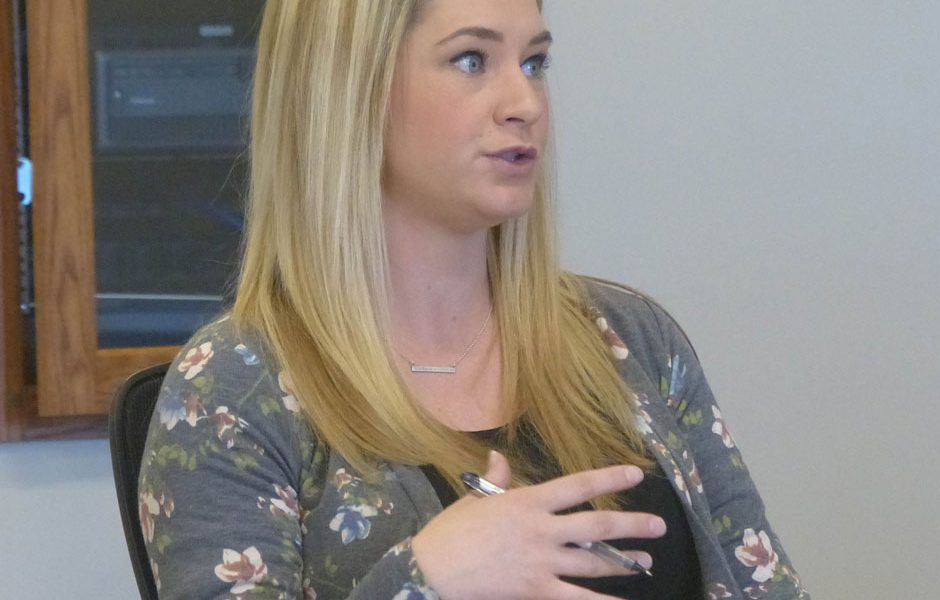
Tiffany Cruickshank, a member of the Eastern Oregon Border Economic Development Board, makes a point during a meeting at Treasure Valley Community College last week. (The Enterprise/Pat Caldwell).
ONTARIO – Land use and developing a stable workforce are the two issues people see as priorities, the chairman of a local board charged with boosting the economy said.
“Everyone is looking for quality workforce and it is an under-met need at all levels,” said Shawna Peterson, chair of the Eastern Oregon Border Economic Development Board.
The seven-member board met Friday at Treasure Valley Community College to establish priorities after hearing from residents, government officials and local industry leaders.
The board is designed to spark economic development, create jobs and tackle gaps in state regulations between Oregon and Idaho that hamper growth. The committee started work in February.
The priority list Friday included topics linked to land use, infrastructure improvements, boosting the local workforce, livability issues, economic development and tax challenges.
Though the board didn’t finalize priorities, Peterson said progress was made.
“We have now, I think, a list that is very vetted and categorized by whether they are policy issues or more in the nature of a program or funding need,” said Peterson.
The board Friday also discussed a communications plan and reviewed logo designs and whether to create a website.
The board already has a page on the Business Oregon website.
Business Oregon is the state economic development agency.
Board members also discussed whether to create Facebook page but discarded the idea.
Peterson said the board began its tenure in a “listening phase” and realized that land use issues and a pool of sustainable employees dominated input.
“We are hearing from a lot of employers that they have open positions but they are having a hard time filling them with qualified candidates,” said Peterson.
For example, said Peterson, Fry Foods, an Ohio-based company that operates a factory north of Ontario, isn’t operating at full capacity because of open positions on its production lines.
Peterson said the board is trying to figure out the best answer to the problem.
One challenge, said Peterson, local employers cite are benefit programs designed to help the unemployed and the poor.
Because of how those government programs are structured, someone who starts earning above a certain income level can lose public benefits.
“They think certain public benefit programs are a disincentive to work. We want to make sure to coordinate those benefits better so they don’t disincentive employment,” said Peterson.
That could take adjustments by the state, Peterson said.
“If someone takes a seasonal job, it wouldn’t disqualify them from a housing benefit and they could keep it still and still work the summer job,” said Peterson.
The board will research the issue.
“We first need to make sure that it is accurate. If so, then maybe the state would extend that benefit or make a smoother process,” said Peterson.
Peterson said another workforce issue is childcare.
“There is a shortage of it for swing shift and weekends and that is a barrier,” said Peterson. “And transportation seems to be a problem with non-traditional shifts.”
Housing also plays a role in workforce development and retaining employees. Peterson said the board received feedback that there are fewer homes to buy and even less space to rent.
Board member Dana Young, who is president of Treasure Valley Community College, said the college often faces that issue. Young said when the college hires a new employee, they usually need to rent, at least short term, but can’t find anything.
“What do they do? They go across the river,” said Young.
Peterson said the board understands that it will also need to review land use challenges by delving into the regulations used by both states.
“We’d look for compromises that would maintain the state’s intent to preserve agriculture ground but show how it could work here,” said Peterson.
Peterson said Oregon’s one-size-fits-all land use regulations may not work in Malheur County.
“We don’t have an urban sprawl problem. So, could we have some unproductive ground around town that might be attractive?” said Peterson.
Reporter Pat Caldwell: [email protected] or 541-473-3377.
FOR $5 A MONTH, GET A DIGITAL SUBSCRIPTION: SUBSCRIBE NOTE: WE DON’T RETAIN OR SHARE YOUR CREDIT CARD INFORMATION WHEN YOU SIGN UP.




